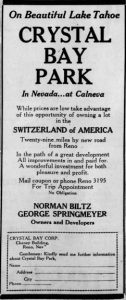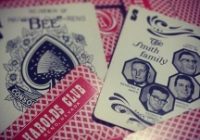|
Listen to this blog post here
Getting your Trinity Audio player ready...
|

Reno Evening Gazette, July 15, 1931
1945-1947
Ray Wherrit and Austin K. Wright of San Luis Obispo, California set out in 1945 to build a $120,000 hotel-casino in the Crystal Bay Park subdivision on the Nevada side of Lake Tahoe. The two had purchased five lots there for that purpose.
In November, after hearing the details of the project, the Washoe County Commissioners approved it.
A number of property owners in the tract petitioned the commissioners to withdraw their approval. Instead, the authoritative body stood by its original decision to greenlight the resort.
The Move to Plan B
For whatever reasons, perhaps due to the protests, Wherrit, with Wright no longer as a partner, downscaled the proposed development to a casino-bar to be built on his lots that, according to the deed, could be used for such a commercial enterprise.
At the time, the town of Crystal Bay already contained some casinos, including the Ta-Neva-Ho and the Cal-Neva Lodge.
Wherrit went before the county commissioners a second time, in February 1946, for permission to proceed. Despite major grumblings from some, construction was approved.
Again, some Crystal Bay Park residents were unhappy with the ruling, which galvanized them to abort the project.
Their efforts, including public objections to such an enterprise being built in their neighborhood, eventually succeeded in getting Wherrit to scrap his plan. At that point, he conveyed the land back to John J. Heffernan, from whom he’d purchased it.
Permanent Solution Sought
In February, about ten residents sued Heffernan and the Crystal Bay Corp. (CBC), the company that originally had subdivided the acreage. The purpose of the suit was to place development restrictions on Heffernan’s property and any unrestricted, CBC-owned land, thereby forever preventing the erection of any similar entities in the future.
The defendants fought back to keep their parcels restrictions free.
The Final Answer
After a delay of more than a year, a non-jury trial finally took place in May 1947 and lasted two days.
Judge A.J. Maestretti ruled in the plaintiffs’ favor. He determined the same limitations on development and use should apply to the entire subdivision and ordered that, accordingly, all property in Crystal Bay Park be built out only for residential purposes.






